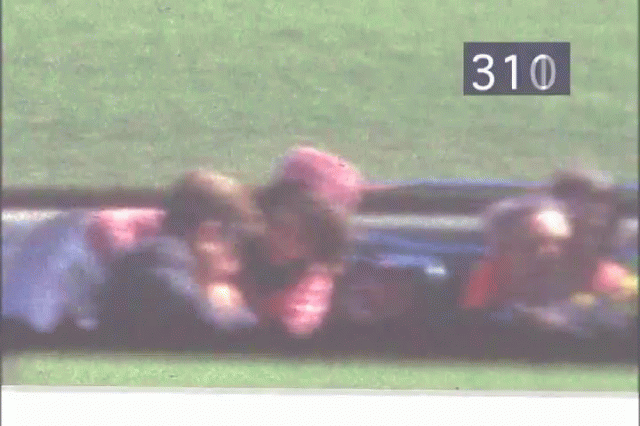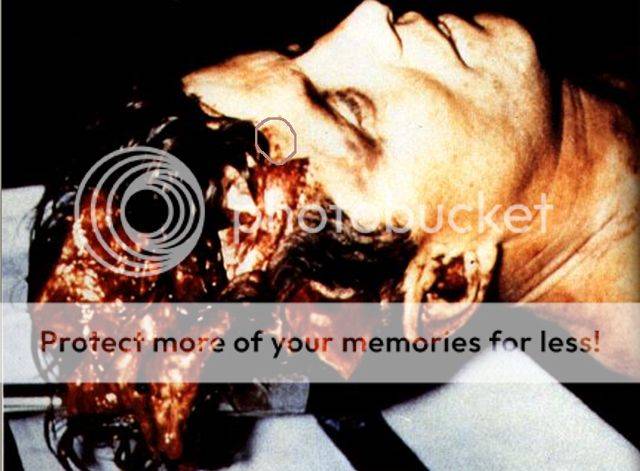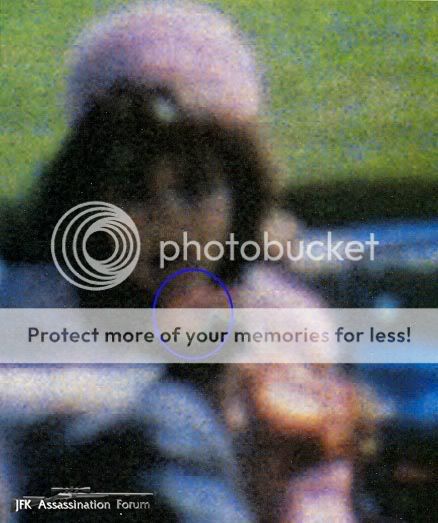Bfgrn
Gold Member
- Apr 4, 2009
- 16,829
- 2,496
- 245
You, in my opinion, only think you know because that is what you want to believe you have too much time invested in trying to prove your case I doubt seriously you are able to walk back from what you have posted.
Here, try this one, an eye witness to the shooting with photos. His testimony is more believable then a person who says she saw an imaginary dog.
TESTIMONY OF HOWARD LESLIE BRENNAN
Mr. BELIN. Would you describe just exactly what you saw when you saw him this last time?
Mr. BRENNAN. Well, as it appeared to me he was standing up and resting against the left window sill, with gun shouldered to his right shoulder, holding the gun with his left hand and taking positive aim and fired his last shot. As I calculate a couple of seconds. He drew the gun back from the window as though he was drawing it back to his side and maybe paused for another second as though to assure hisself that he hit his mark, and then he disappeared.
And, at the same moment, I was diving off of that firewall and to the right for bullet protection of this stone wall that is a little higher on the Houston side.
Mr. BELIN. Well, let me ask you. What kind of a gun did you see in that window?
Mr. BRENNAN. I am not an expert on guns. It was, as I could observe, some type of a high-powered rifle.
Mr. BELIN. Could you tell whether or not it had any kind of a scope on it?
Mr. BRENNAN. I did not observe a scope.
Mr. BELIN. Could you tell whether or not it had one? Do you know whether it did or not, or could you observe that it definitely did or definitely did not, or don't you know?
You have already been forced to walk back from what you posted.
Freewill Post 534 said:First shot hit Kennedy in the back and lodges there later to become the "pristine" bullet.
Second shot misses Kennedy and hits Connelly with the bullet fragmentizing..
The third hit Kennedy in the head.
Either way three shot, three from the same person three from Oswald.
While I am good with the single bullet theory it could have gone down in the way I describe and that still does not point to conspiracy.
You better be more than good with the single bullet theory. You are locked into it now, because one of your three shots totally missed the limousine, hit a curb and injured a bystander.
So we are back to square one...
a) You can start by explaining how Oswald was able to fire off the last 2 shots almost simultaneously using a poorly operating bolt action rifle?
b) Then explain how John Connolly could have possibly had a 'delayed reaction' to the grievous wounds that ripped through his chest. To his dying day Connolly vehemently said he was not hit by the first bullet.
Governor Connally told the Warren Commission, "I was turning to look back over my left shoulder into the back seat, but I never got that far in my turn. I got about in the position I am in now facing you, looking a little bit to the left of center, and then I felt like someone had hit me in the back."(1) He elaborated to the House Select Committee on Assassinations (HSCA) "...so I was in the process of, at least I was turning to look over my left shoulder into the back seat to see if I could see him. I never looked, I never made the full turn. About the time I turned back where I was facing more or less straight ahead, the way the car was moving, I was hit. I was knocked over, just doubled over by the force of the bullet. It went in my back and came out my chest about 2 inches below and to the left of my right nipple. The force of the bullet drove my body over almost double and when I looked, immediately I could see I was just drenched with blood. (2)
(1) Robert J. Groden & Harrison Edward Livingstone, "High Treason" (New York: Berkley Book 1990) p.272-273
(2)The Report of the Select Committee on Asssassinations U.S. House of Representatives; Vol. 1, p.42
c) Explain how the bullet that entered the President's back and created a shallow wound which was probed during the autopsy and the bottom of the wound could be reached with a human finger exited his throat, from a wound described as an entrance wound by Parkland doctors that was 6 inches higher than the back wound?
I did not walk back on anything. What you quote is not in context to the discussion we were having. You wanted a different scenario and that is what I provided. If you read the last sentence I said I have no problem with the single bullet theory. It was actually a mistake on my part in response to your c). What you describe is not what happened the doctor never said the end of the wound was found. The bullet, by every freakin account, went right through the president, never hitting anything particularly hard.
As for Connelly, I can't explain his reaction and neither can you. Explain how he held his hat up to Parkland with a shattered wrist.
Wrong...the bullet did not go through the President.
Paul K. O'Connor
Paul O'Connor was asked to assist Joseph Humes, Thornton Boswell and Pierre Finck in the autopsy of Kennedy.
Paul O'Connor was interviewed by William Matson Law for his book, In the Eye of History: Disclosures in the JFK Assassination Medical Evidence.
OConnor: When we started an autopsy, the first thing we always did was
to weigh and measure the body. Wed check for any scars, contusions, any
abnormalities, and so on. But in this case, we didnt turn the body over to
look at the back while we were doing that. Finally we turned the body over,
and there was a bullet woundan entrance woundin his back, on the right
side of his spinal column. To emphasize where it was in proximity to the rest
of his body: if you bend your neck down and feel back, you feel a lump and
thats the seventh cervical vertebra. This bullet wound was about 3 inches
down and an inch or two to the right of the seventh cervical vertebra. I
remember there was a big gush of surprise that nobody actually thought
about turning him over right away, you know after we had done our initial
investigation of the presidents body. Dr Humes took his finger and poked it
in the hole---the bullet wound hole, the entrance wound hole---and said it
didnt go anywhere. There was a very big argument, a lot of consternation,
that he shouldnt have stuck his finger in the hole.
Law: What difference would it make?
OConnor: Well, when you take your finger and stick it into a bullet wound,
you avulse the wound.
Law: You think that happened when he stuck his finger in the back?
OConnor: Yes
Law: It could have create a false track:
OConnor: Well, not necessarily a false track, as much as a false impression
of the entrance of the missile that went into his back.
Law: Who was arguing?
OConnor: Dr. Finck strongly objected to Commander Humes doing what he did.
He [Finck] took a sound, which is a probe, a metal malleable, non-rigid probe. We
started out with a rigid probe and found that it only went in so far. Id say maybe
an inch and a quarter. It didnt go in any further than that. So we used a malleable
probe and bent it a little bit and found that the bullet entered the body, went
through the intercostals muscles---the muscles between the ribs. The bullet went
in through the muscles, didnt touch any of the ribs, arched downwards, hit the
back of the pleural cavity and stopped. So we didnt know the track of the bullet
until we eviscerated the body later. Thats what happened at the time. We traced
the bullet path down and found that it didnt traverse the body. It did not go in one
side and come out the other side of the body.
Law: You can be reasonably sure of that?
OConnor: Absolutely
Law: And these doctors knew that?
OConnor: Absolutely
Law: While it happened?
OConnor: Absolutely. And another thing we found out while the autopsy was
proceeding, that he was shot from a high building, which meant the bullet had to be
traveling in a downward trajectory and we also realized that this bullet is what we
call in the military a short shot. It didnt have the power to push the projectile clear
through the body. If it had it would have come out through his heart and through
his sternum.
OConnor: We were told [in the report of the Warren Commission] that he was
shot in the back and it came out his throat. That didnt jibe with what we saw, and
when I say we, Im talking about Dr. Boswell and myself.
. . . . When LAW then showed OCONNOR the photo of President KENNEDYs back . . . .
OConnor: Thats a very accurate portrayal of the entrance wound to his back,
which as you know, is quite a ways down from his neck. At the angle he was
shot the laws of physics will not let a bullet strike there and go up and go
out his throat I helped roll him over one of these arms might have been
mine, because I was at the head of the body and helped roll him over. It
wasnt rolled over until quite a ways into the autopsy, and thats when they
discovered the bullet wound.
. . . . OCONNOR further stated to LAW . . . .
Now I had this drawing made at the University of Florida showing the back
wound and this is exactly what happened. The bullet struck him in the back,
it passed through the outer layer of muscle and through the inner layer of
muscle between the vertebrae. These are intercostals muscles and they
connect the spinal column together. This bullet came in, arched downward,
and bulged against the pleural cavity, which is the protective cavity around
both lungs. It did not penetrate that lung area. It just bruised it real badly.
I had it highlighted showing there was bruising on the right lung. The back
of the right lung was bruised, but wasnt torn. It was bruised badly enough
to hemorrhage in the tissues, but not enough to tear the lung or the cavity.
"and we also realized that this bullet is what we
call in the military a short shot I believe that this shot was being aimed at the back of the presidents head but because it lacked the power to penetrate as Paul O'Conner states it feel short hitting him in the upper back.









 They couldn't see much until someone picked up his head.
They couldn't see much until someone picked up his head.
